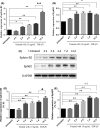RNAi-mediated ephrin-B2 silencing attenuates astroglial-fibrotic scar formation and improves spinal cord axon growth
- PMID: 28834283
- PMCID: PMC6492699
- DOI: 10.1111/cns.12723
RNAi-mediated ephrin-B2 silencing attenuates astroglial-fibrotic scar formation and improves spinal cord axon growth
Abstract
Aims: Astroglial-fibrotic scar formation following central nervous system injury can help repair blood-brain barrier and seal the lesion, whereas it also represents a strong barrier for axonal regeneration. Intensive preclinical efforts have been made to eliminate/reduce the inhibitory part and, in the meantime, preserve the beneficial role of astroglial-fibrotic scar.
Methods: In this study, we established an in vitro system, in which coculture of astrocytes and meningeal fibroblasts was treated with exogenous transforming growth factor-β1 (TGF-β1) to form astroglial-fibrotic scar-like cell clusters, and thereby evaluated the efficacy of RNAi targeting ephrin-B2 in preventing scar formation from the very beginning. We further tested the effect of RNAi-based mitigation of astroglial-fibrotic scar on spinal axon outgrowth on a custom-made microfluidic platform.
Results: We found that siRNA targeting ephrin-B2 significantly reduced both the number and the diameter of cell clusters induced by TGF-β1 and diminished the expression of aggrecan and versican in the coculture, and allowed for significantly longer extension of outgrowing spinal cord axons into astroglial-fibrotic scar as assessed on the microfluidic platform.
Conclusions: These results suggest that astroglial-fibrotic scar formation and particularly the expression of aggrecan and versican could be mitigated by ephrin-B2 specific siRNA, thus improving the microenvironment for spinal axon regeneration.
Keywords: astroglial-fibrotic scar; axonal regeneration; ephrin-B2; microfluidic platform; siRNA; spinal cord injury.
© 2017 John Wiley & Sons Ltd.
Conflict of interest statement
We declare that we do not have any conflict of interest.
Figures






References
-
- Ramer LM, Ramer MS, Bradbury EJ. Restoring function after spinal cord injury: towards clinical translation of experimental strategies. Lancet Neurol. 2014;13:1241‐1256. - PubMed
-
- Rolls A, Shechter R, Schwartz M. The bright side of the glial scar in CNS repair. Nat Rev Neurosci. 2009;10:235‐241. - PubMed
-
- Fabes J, Anderson P, Yanez‐Munoz RJ, et al. Accumulation of the inhibitory receptor EphA4 may prevent regeneration of corticospinal tract axons following lesion. Eur J Neurosci. 2006a;23:1721‐1730. - PubMed
MeSH terms
Substances
LinkOut - more resources
Full Text Sources
Other Literature Sources
Medical

